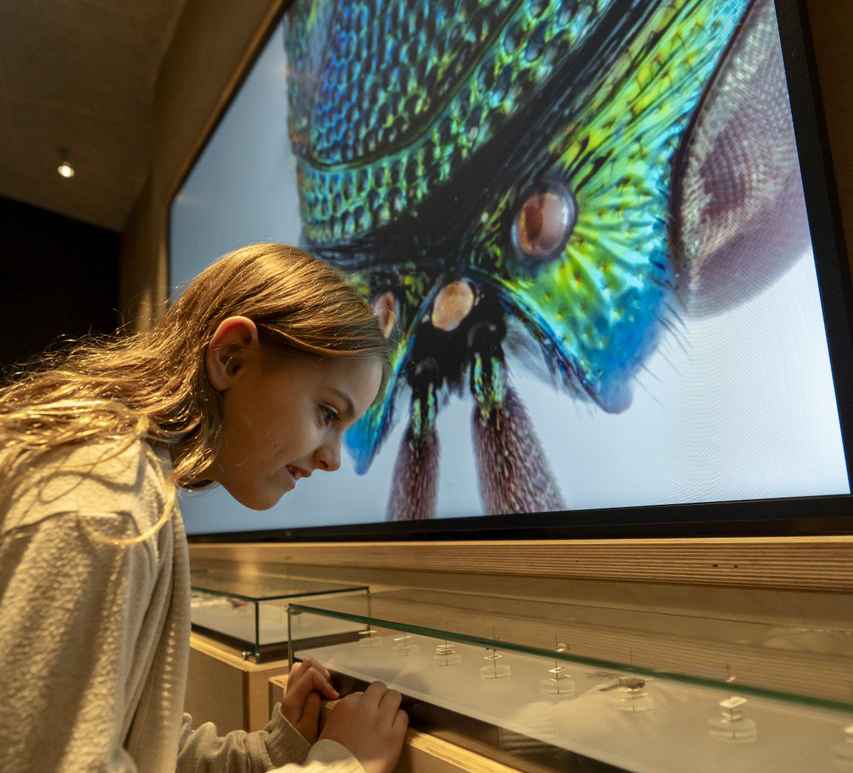One month of the Wascana Turtle Program is now complete and I cannot believe how fast time is flying by. With the assistance of ninja reflexes and keen eyes, we have now been able to find 30 turtles in Wascana Marsh, 15 of which are equipped with radio-transmitters. These turtles range in size from 9 cm to our potential record breaker with a 26.6 cm carapace length. Seeing such a wide variety in size and ages of individuals is quite exciting for me, as it shows recent recruitment into the population.
So far I have been able to find two individuals who are between 2-3 years old. These little guys are typically the hardest for researchers to find, which is why biologists have a hard time studying their habitat movements. Although these two individuals are too small to be outfitted with a transmitter, both of them have been given unique notch codes (like the adults) so that should we see them again we can plot new location data points. However, unlike the adults those little tykes did not have painted numbers written on the back of their shell. Although they are larger and their shells are harder, the little turtles still have high risks of predation therefore we want to minimize any potential threats.
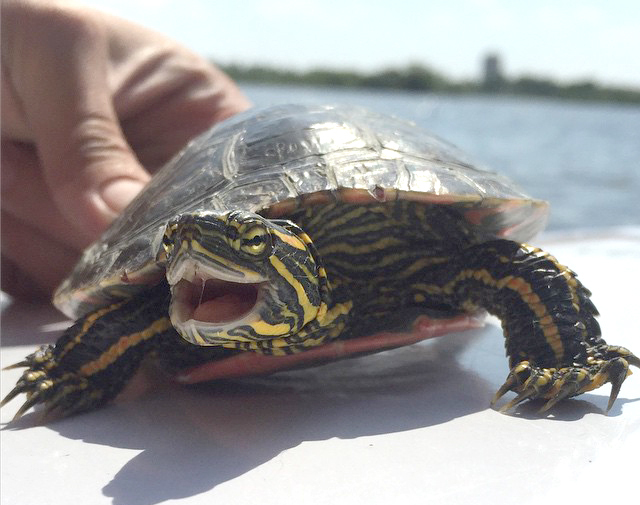
A feisty little juvenile caught earlier this week. This feistiness is what has helped him/her survive the past three years, and will keep helping him/her many years into the future.
The beginning of June was also a very exciting time for me and my field tech Alyssa. On June 2nd we were out tracking the turtles and had recently finished processing a young female turtle. As we were finishing up, I looked out across the water and saw a large turtle head poking out. It was the largest turtle head that I had seen so far during my time in Saskatchewan. I hopped up off the ground, pulled the straps of my waders over my shoulders, and went dashing out into the water to try and catch this turtle. Although this seems like an easy feat, dashing through the water meant sinking about a foot or more into muck with every step so this dash was in slow motion. With luck on my side however, I was able to get out to the area where I has seen the head pop out of the water and thankfully this turtle hadn’t moved too much. I could see her shell through the water, so I reached down, grabbed her, and lifted the largest western painted turtle I have ever seen out of the water. I called out to Alyssa to show her my find and hastily walked back so we could see how big she was. With shaky, excited hands we pulled out the calipers and did an initial estimate of her size and this girl clocked in at over 26 cm. We continued to process her and gave her a transmitter, and then when our excitement calmed down, I measured her more precisely. This female ended up having a carapace length of 26.6 cm and a plastron length of 25.3 cm. The largest western painted turtle previously on record had a carapace length of 25.4 cm and was recorded in 1922, meaning that this girl could possibly be the largest western painted turtle found in North America and she was found right here in Regina!! Finding her opens up a whole new can of ideas about these turtles as well as so much more excitement. Based on her size, Olga is a very old turtle ranging in age from 25-50 years and oh how I wish she could tell us some stories. Where did she go during the big dig? Why did she choose Regina to be her home? Where does she like to hang out throughout the year? How many clutches of eggs has she laid, and where does she lay them? Some of these questions I will hopefully be able to answer in a couple of years, but unfortunately for us, the answers to some questions will remain her secrets forever.
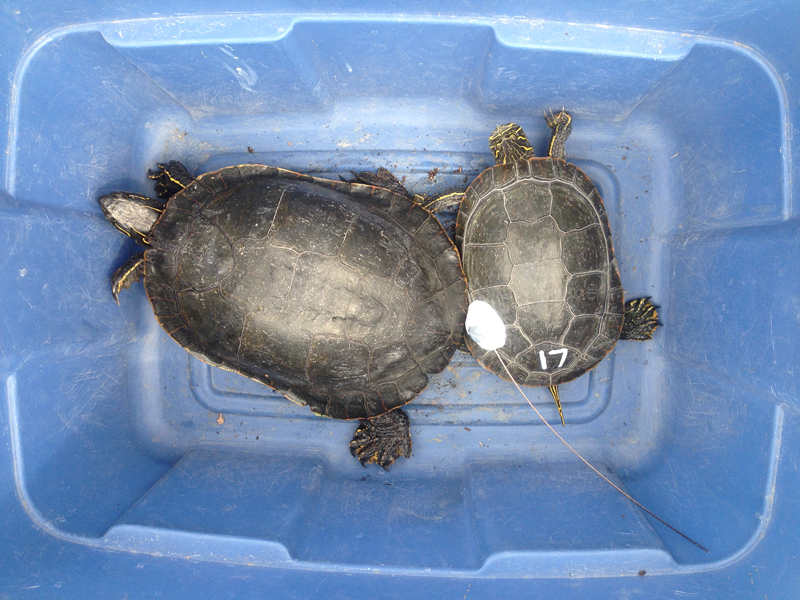
Olga (left) next to Rachel, a young Western Painted Turtle.
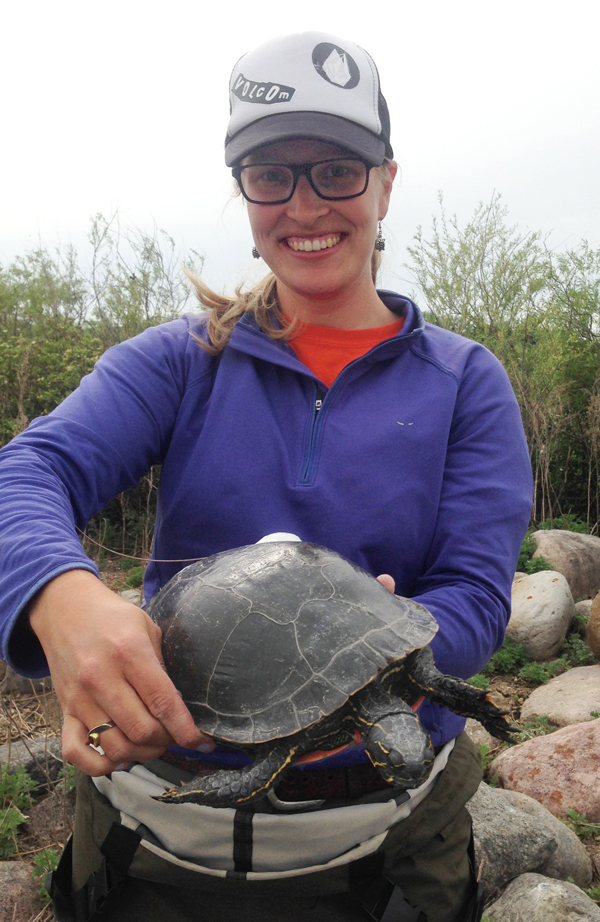
Olga and I posing for a picture prior to her release back into the marsh.
Reading that last paragraph, you may be curious as to what a clutch is. A clutch is a word used for the group eggs that the females will lay. The amount of eggs that a turtle can lay depends on the size and the species of turtle, with larger turtles being able to produce more eggs. Unlike the birds found in the Habitat Conservation Area, turtle eggs are actually buried underground in a dugout cavity that a female makes with her hind legs. Digging this cavity takes a female many hours as each scoop is done with precision and care. When the females are finished laying their eggs, they fill the hole back up and cover it over, and to an unknowing passerby the soil would appear as if nothing ever happened. The eggs will then incubate in the soil and when the turtles hatch in late August they will either make their way to the wetland or they will supercool and spend their first Canadian winter inside their natal nest and emerge the following spring. The location of the nest is incredibly important, as the eggs need the suns warmth for incubation. A neat fact about painted turtles, as well many turtle species, is that the sex of the hatchlings isn’t determined based upon genetics. The sex of the turtle is determined based upon the temperature of incubation! Cooler incubation temperatures will result in male painted turtles, and warmer incubation temperatures will result in female painted turtles. How neat is that!
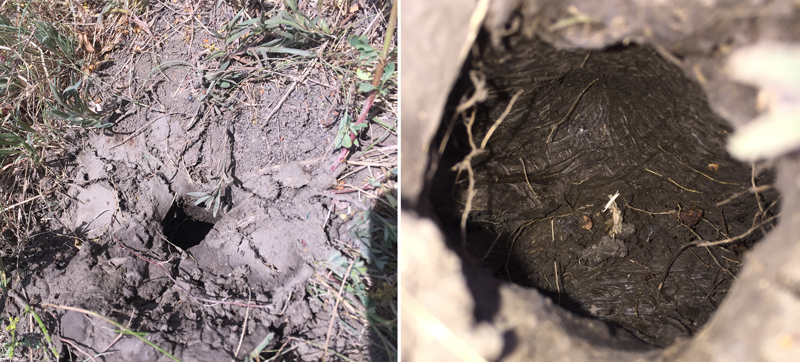
A look at the top (left) and inside (right) of an abandoned turtle nest cavity. If you take a close look at the picture on the right, you can see her claw marks along the inside that she left behind as she dug the hole.
Although nesting seems easy enough, turtle nests face many threats. Mother turtles can get scared off their nests leaving their eggs exposed an vulnerable and even when complete, the nests are susceptible to predators like dogs, cats, foxes, coyotes, raccoons, crows, and squirrels to name a few. A way you can help is if you are out walking your dog, especially on the north shore of Wascana, please keep a close eye on them. Please keep them on a leash and try not to let them venture too far from the packed down path. Many female turtles lay their nests in the grass. You may not be able to see them, but the dogs will be able to sniff them out and scare the females off. One female I was tracking took half an hour to climb up the hill, she finally got to the top and a dog went into the grasses barking after her and she ran down the hill in less than two minutes. She didn’t try again that night, but thankfully she came back the next night and I acted as her personal guardian by keeping dogs high on the trail. She was able to lay her eggs and go safely back down into the marsh where she will spend the rest of her summer.
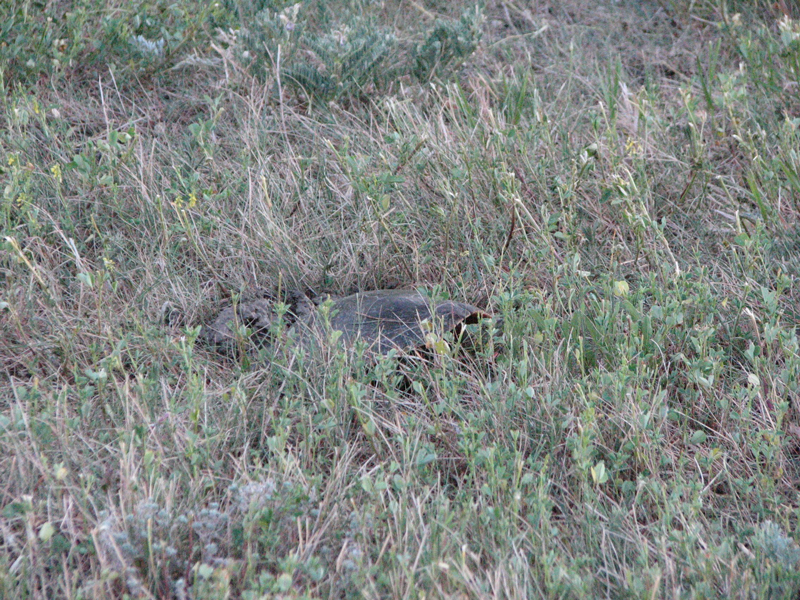
The females try to remain so well hidden, if you aren’t watching, you would never know they are there. Please keep your dogs close when walking along grassy areas during the month of June.
While you are walking around Wascana, if you see a turtle on land or in the water please feel free to let me know so we can add your sightings to our database. As mentioned in the previous blog, the information I need is: where you saw it, when you saw it, what it was doing, and if possible, a picture of the turtle. You can send your sightings to turtles@royalsaskmuseum.ca So far I have received sightings from around the Saskatchewan Science Center, on rocks in Wascana Lake, in the water at A. E. Wilson Park, and along the shore near Wascana Parkway. Please remember to observe the turtles, but please do not handle the turtles unless they are in danger.

